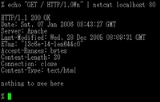
Netcat
Overview
Transmission Control Protocol
The Transmission Control Protocol is one of the core protocols of the Internet Protocol Suite. TCP is one of the two original components of the suite, complementing the Internet Protocol , and therefore the entire suite is commonly referred to as TCP/IP...
or UDP
User Datagram Protocol
The User Datagram Protocol is one of the core members of the Internet Protocol Suite, the set of network protocols used for the Internet. With UDP, computer applications can send messages, in this case referred to as datagrams, to other hosts on an Internet Protocol network without requiring...
. Netcat is designed to be a dependable “back-end” device that can be used directly or easily driven by other programs and scripts. At the same time, it is a feature-rich network debugging and investigation tool, since it can produce almost any kind of correlation you would need and has a number of built-in capabilities.
Netcat is often referred to as a "Swiss-army knife for TCP/IP." Its list of features includes port scanning, transferring files, and port listening, and it can be used as a backdoor.
Some of netcat's major features are:
- Outbound or inbound connections, TCP or UDP, to or from any ports
- Full DNS forward/reverse checking, with appropriate warnings
- Ability to use any local source port
- Ability to use any locally-configured network source address
- Built-in port-scanning capabilities, with randomization
- Built-in loose source-routing capability
- Can read command line arguments from standard input
- Slow-send mode, one line every N seconds
- Hex dump of transmitted and received data
- Optional ability to let another program service established connections
- Optional telnet-options responder
- Featured tunneling mode which allows also special tunneling such as UDP to TCP, with the possibility of specifying all network parameters (source port/interface, listening port/interface, and the remote host allowed to connect to the tunnel.
{ echo -ne "HTTP/1.0 200 OK\r\n\r\n"; cat some.file; } | nc -l -p 8080
{ echo -ne "HTTP/1.0 200 OK\r\nContent-Length: $(wc -c
The file can then be accessed via a webbrowser under

